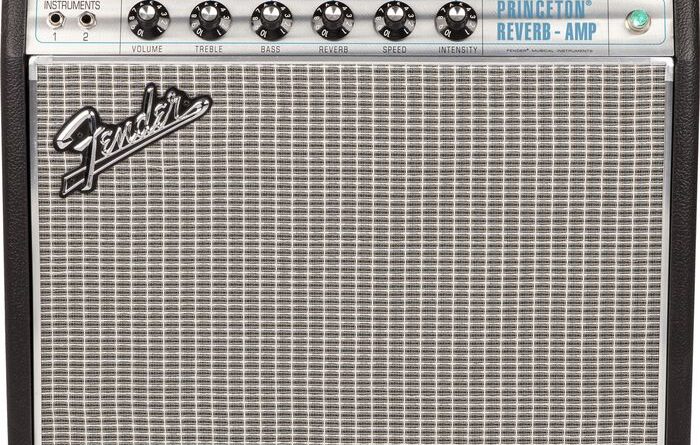Fender ’68 Custom Princeton Reverb
Model/Circuit Number: Fender ’68 Custom Princeton Reverb
Years of Production: 2013 – Present
Era: Vintage Modified
Configuration: Combo
Controls: Silver front facing w/ blue screened labels
Knobs: Black skirted w/ chrome center, numbered 1 – 10
Faceplate
- Front: Instruments 1 & 2, Volume, Treble, Bass, Reverb, Speed, Intensity, Blue jewel pilot
- Rear: Power cable port, 2A fuse, Power switch, Int speaker jack, Ext speaker jack, Footswitch jack, Reverb output, Reverb input
Cabinet
- Dimensions: 16″ H X 19.875″ W X 9.5″ D
- Handle: Vinyl strap w/ nickel plated caps
- Feet: Round black rubber
Covering Material
- Tolex/Tweed: Black Tolex
- Grill Cloth: Blue sparkle w/ aluminum drip edge frame
Logo: Grille mounted, raised, chrome & black script “Fender” w/ tail
Weight: 34 lbs.
Speakers/Load: 1 x 10″ / 8 ohms
- Speaker Model: Celestion TEN 30 ceramic
Effects: Reverb, Tremolo
Watts: 12 Watts
Tubes
- Pre amp: 1.5 X 12AX7 preamp, 0.5 12AX7 phase inverter, 1 X 12AX7 reverb recovery & tremolo oscillator, 1 X 12AT7 reverb driver
- Power: 2 X 6V6GT
Bias: Fixed
Rectifier: 1 X 5AR4
Comments:


When 2 6V6 tubes put into a Deluxe Reverb puts out 22 watts, what limits this amp to only 12 watts with identical power tubes? If Fender put in an output transformer only rated at 12 watts, that’s the same error they made on the 15 watt Tweed Deluxe amps running a pair of 6V6 tubes. Why would they do that?
The phase inverter of the Princeton Reverb is part of its sound. If you were to use the long-tailed pair of the Deluxe Reverb, it wouldn’t sound like a Princeton, although it would then achieve a higher power output. The Princeton inverter has outputs at its cathode and anode; these are out of phase and are capacitively coupled on to the power tube grids. However, they each can only swing to a peak which is half the plate voltage. To put it another way, the cathodyne inverter, as used in the Princeton, is not as efficient as the long-tailed pair. You would have to increase the plate voltage on the cathodyne phase inverter quite a bit beyond safe operation if your goal was to meet a 22 watt power spec.
The PR is closer to 15W. An amp’s maximum output is determined by the power tubes but more often than not it is limited by the transformer set. A pair of 6V6s can put 30W but most designers do not run them at their maximum. Fender chose to use a transformer set than can only produce 12 to 15W on a PR. This made the amp cheaper to produce and also allowed them to use a lighter speaker. All that said a Deluxe Reverb’s 22W rating is very generous. 17 to 20W is more arcuate.
To create another model in the line of amps. Plus as power requirements increased models were renamed .The Deluxe tweed started as a 12 watt and eventually went to 22 watts. The Tweed twin started out as 35 watts and went to 135 watts!
what type of tremolo is on a 1972 Silverface Princeton Reverb